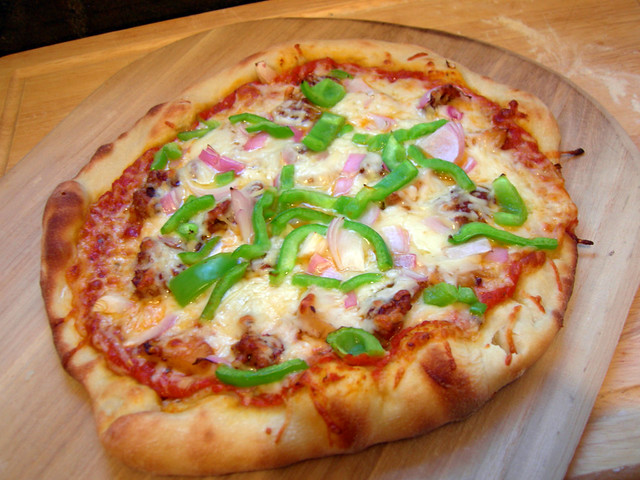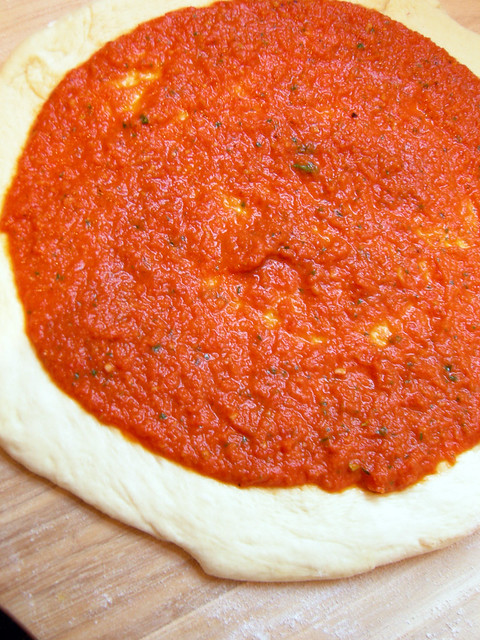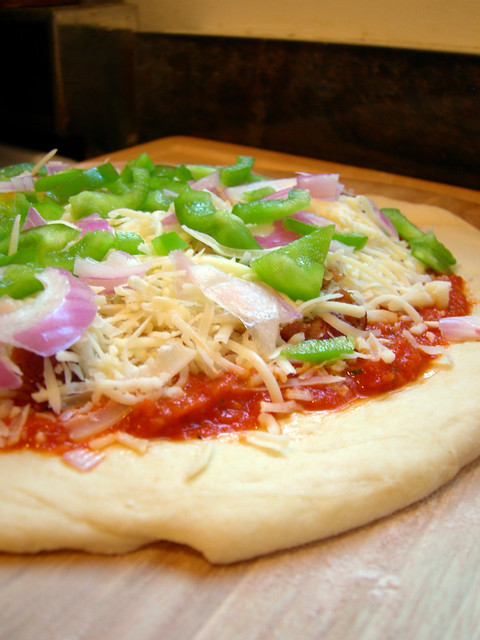Sourdough Pizza Crust and Simple Tomato Sauce

One of the easiest applications of sourdough starter is pizza crust. I've made this pizza dough dozens of times. It took quite a bit of tweaking to get just right, but I think I've finally got it down. Unlike most yeast-leavened breads, this crust can be made in just a few hours. If you have 15 minutes before you leave the house in the morning, you can come home to a well-risen dough that can be turned into delicious pizza in half an hour or so.
Combined with a good tomato sauce (recipe below), you can make way better pizza than anything a delivery boy is going to bring. And it will cost a lot less, too.
This recipe makes enough dough for two 12-inch pizzas.
Sourdough Pizza Crust
- 1 1/2 cups active sourdough starter
- 1 1/2 cups bread flour*
- 2 tablespoons olive oil
- 1 3/4 teaspoons salt
- 1 tablespoon honey
*You can make your own bread flour using all-purpose flour, and adding 1 tablespoon of wheat gluten for every cup of flour.
Place the starter, olive oil, salt, and honey in a large bowl, and stir to combine. Add the flour, and stir to combine. At this point, the dough will be sticky and shaggy. Place the dough onto a well-floured board, and knead, adding flour as needed to keep it from sticking. Knead the dough for about 5 minutes, until it becomes smooth and elastic. When it's done, it might be a little bit sticky, which is fine. But it should not be nearly as sticky as it was when you started.
Pour a small amount (less than a tablespoon) of olive oil into a large, clean bowl. Place the dough in the bowl, and turn it over in the olive oil, to coat it. Cover the bowl with plastic wrap, and allow the dough to rest, at room temperature, for at least 3 hours. It will probably rise quite a bit, and will likely double, at least. However, if it doesn't rise very much, don't worry. It will still work. If you're going to let it rise for longer than 4 or 5 hours, you should put the dough in the refrigerator, to slow the process down. A slow rise in the refrigerator can actually make a slightly better dough than a fast rise, developing more complex flavors.

Pizza dough after rising for several hours.
Tomato Sauce

This sauce is sublime in its simplicity. The key is to start with really good San Marzano tomatoes, and to avoid messing with them too much. It's very important to use San Marzano tomatoes, and not a can of generic "diced tomatoes". I can't stress this enough. The sauce will not be the same without them. They cost a little more, but it's well worth it.
- 1/4 cup olive oil
- 2 cans (23 Oz. each) diced San Marzano tomatoes, drained.
- 4-5 cloves garlic, chopped
- 1 teaspoon fennel seed, toasted and ground
- 2 large handfuls of fresh basil leaves
- 2 bay leaves
- 1 tablespoon balsamic vinegar
- Salt
- Freshly-ground black pepper
Heat a small frying pan over medium heat. Add the fennel seeds, and cook them until they darken in color, and become extremely aromatic - 2 or 3 minutes. Immediately transfer them to a small bowl so they don't burn in the pan. Grind them in a spice grinder or with a mortar and pestle.
Pour the olive oil into a stockpot or large saucepan, on medium-low heat. Add the garlic, and cook until it's soft, aromatic, and slightly browned - about 2 minutes.
Pour the tomatoes into a strainer, to drain out as much of the liquid as possible. Add the tomatoes to the pot, along with the bay leaves, balsamic vinegar, a few heavy pinches of salt, and several grinds of black pepper.
Simmer on low, uncovered, for about 25 minutes. Taste the sauce, and adjust the seasonings as desired.
Turn off the heat, and add the basil leaves (you can keep them whole, since the sauce is getting pureed anyway) and fennel. Puree with an immersion blender until the sauce is smooth, and there are no large chunks of basil visible. You can also do this in a blender or food processor.
Assembling the Pizza
Preheat oven to 550.
Turn the dough out onto a well-floured board, and cut it in half. Place one half back into the bowl. Using your hands, or a rolling pin, slowly stretch the dough out to the desired size. If the dough sticks or tears, you can smash it back into a ball, and start over. But I'd try to avoid doing this more than once or twice, so as not to overwork the dough, which would change its texture.
Continue to sprinkle flour onto the rolling pin, your hands, the cutting board, etc. to keep the dough from sticking. However, try to use the bare minimum amount of flour required to prevent sticking.
When the dough is rolled out, dust a pizza peel (or whatever you're going to use to transfer the pizza to the oven - a large piece of cardboard, or a rimless baking sheet will work) with a layer of flour or cornmeal. Place the dough on the peel.
Ladle some sauce onto the center of the dough, and use the ladle to spread it around. You don't need a ton of sauce, but there's no reason to skimp, either. You could probably get away with using a little less than the amount pictured here.

Every 20 seconds or so, you should give the pizza peel a good shake, to ensure that the pizza still slides freely. Add cheese, and your favorite toppings. In case you're wondering, this one is topped with Italian sausage, trumpet mushrooms (those two are under the cheese, so you can't really see them), green bell peppers, and red onions. Of course, you can top yours with whatever you like.

Slide the pizza onto a hot pizza stone, or a cookie sheet, and bake at 550 for 10-15 minutes, until the crust is golden-brown, and the cheese is melted and bubbling.
Move the pizza to a cutting board, and let it rest for about 5 minutes before slicing.

